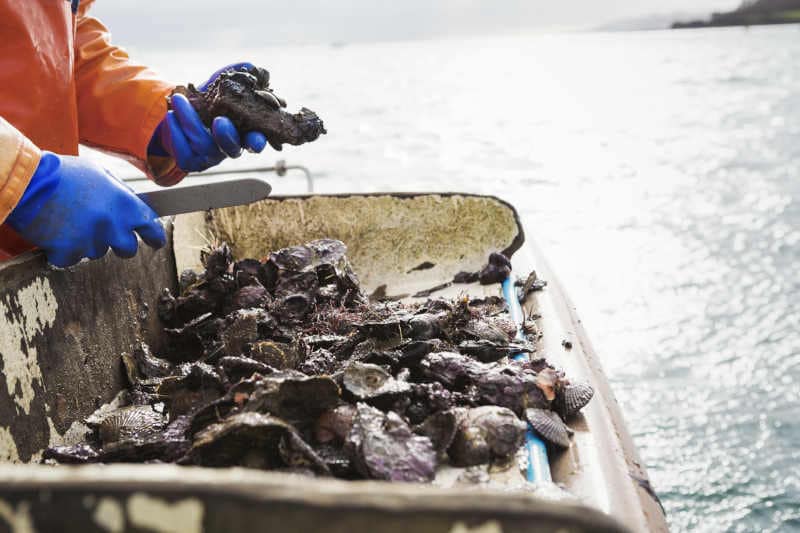Oysters can survive out of water for two to three weeks if stored adequately.
Clams can survive out of water too, but not as long as oysters, that is, only around five to six days. Mussels can survive out of water for up to three days.
Despite the ability to survive out of water for a specific period of time, seafood is best when eaten as soon as caught or purchased from the market.
Oysters need to be kept in the right conditions because once they die, they’re no longer safe for consumption!
Storing oysters properly also requires the right temperature. This should be one below 40 degrees F. If it goes below 35 degrees F, it can kill the oysters. Oysters need to be alive to be safe for consumption, so don’t forget about this too!

Below, check out some tips for proper oyster storage and safe consumption!
Table of Contents
How to Store Oysters after Buying Them?
When you don’t plan to eat the oysters right after purchasing them and are not sure how long can oysters live out of the water, it’s essential to store them right away.
This will keep them fresh and alive for a period of two to even three weeks. This span is shorter in clams and even shorter in mussels.
After buying your oysters, store them in a moist environment. The fridge is great for this; choose the coldest section according to your fridge design. Cover them with a moist cloth, keep them in the box they came in, or in a metal bowl.
Colanders or perforated pans are also excellent. They allow you to keep the oysters on ice which enables the water to drain out.
Otherwise, don’t put ice underneath because it will melt and cause the oysters to be submerged in water. This will have a negative effect on their quality and end up killing them!
Don’t forget to keep them with the curved side down or cupped to maintain the natural juices.
Submerging oysters in freshwater shouldn’t be done. Oysters need moisture to breathe. Don’t place them near fans and avoid tightly closed bags or containers either.
How to Know If Oysters Are Alive or Dead?
Checking if oysters are safe for consumption, that is, if they’re alive or dead, is pivotal. According to Safe Oysters Organization, you can easily check this by tapping on the shell. If it closes, it means the oyster is alive and safe for eating.
But, if it’s gaping open or if it doesn’t close after you tap on it, it means it’s dead and the risk of bad bacteria is high. These oysters mustn’t be consumed because they can cause diseases.
Once upon a time, it was considered that oysters should be consumed only in the months with the letter “r” in them, that is, September, October, November, and December. But, this isn’t the case any longer.
Oysters were once thought to be best for consumption during warm weather when they were shipped with a lack of adequate refrigeration and therefore a high risk of spoilage.
Today, things have changed a lot and oysters are available all year round.
How to Prep Oysters for Consumption?
Once the time for shucking and eating comes, take out the oysters from the fridge and transfer them into a colander. Rinse them well under running water in the sink and put on gloves. Remove any mud and loosen bits you notice during the inspection.
After this step, it’s time for shucking and serving or cooking. To ensure smooth shucking, you need the right equipment. This can be a quality shucking knife or a shucking machine.
The knife is a better option for the more experienced shuckers whereas a shucking machine is recommendable for those who’re less savvy in using a shucking knife or people who tend to prep a lot of oysters (restaurants, etc. )
When working with oysters, it’s pivotal to protect your hands. The best way to do this, especially when using a knife, is to wear protective gloves. They’re made of strong materials that offer different levels of protection. They will also enable you a better grip and working angle.
If you’re not sure which gloves to choose, take into account your shucking experience. That is, the less experience you have, the stronger the glove needs to be. Don’t forget about comfort- another contributing factor.
How to Consume Oysters?
Oysters are commonly consumed raw, straight out of the shell. However, there are plenty of other ways you can cook and include them in your diet. You can grill, roast, broil, bake, add them to stews, etc.
Whichever option you choose, one thing’s for sure: oysters are an acquired taste. Those who regularly consume them describe them as buttery and creamy with a rusty and coppery taste and with notes of sweetness and saltiness.
Those who’re not the biggest fans of oysters dislike the “taste of the ocean” where they came from, which is inevitable and actually a sign of a quality oyster!
Final Thoughts
Oysters can be a real delight for seafood lovers so it’s crucial to ensure they remain fresh if not consumed right after being purchased. Many wonder how long can oysters live out of water. The good news is that they can!
They’re able to survive in proper storing conditions for up to three weeks, although they’re always the best when eaten right after being bought.
Oysters should be stored in the coldest part of a fridge, never covered. This is because they need proper airflow to stay alive and safe for consumption.
Since they can harbor bad bacteria after dying, oysters must always be checked before consumption to reduce the risk of illnesses. Light taps onto the shell which causes movement is a sign of freshness. Otherwise, they’re ready for the bin.
Although commonly consumed straight out of the shell, there are some excellent ways to cook them and create yummy and unforgettable dishes for the whole family!
